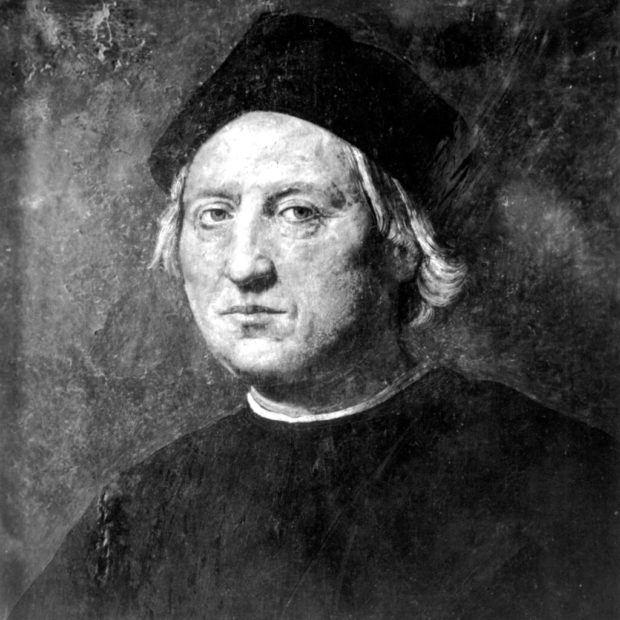
This undated portrait attributed to Rodolfo Ghirlandaia shows Italian explorer Christopher Columbus. (AP)
ALBUQUERQUE, New Mexico — The image and story of Christopher Columbus, the 15th century navigator who began European incursions into the Americas, have changed in the U.S. over the decades. Columbus was an obscure figure until his adventures were revitalized in the 1800s. By the 1990s, a new generation of Native American activists blamed the navigator for launching centuries of indigenous genocide. With Columbus Day falling on Monday in the U.S. — and now being called Indigenous Peoples’ Day in some states — here’s a look at how views of Christopher Columbus have changed over the years:
The man
Born in the Republic of Genoa (now Italy), Columbus took part in several voyages in the Aegean and Mediterranean seas as a teenager and later participated in expeditions to Africa. Like Aristotle and others, Columbus believed that the world was round. He theorized that the distance between Spain’s Canary Islands and Japan was only around 2,300 miles (3,701 kilometers) and felt he could sail west to reach Asia for a new sought-out route for spices.
It was really about 12,000 miles (19,321 kilometers). Columbus based his incorrect calculations on mystical texts, and ended up landing in the present-day Caribbean on Oct. 12, 1492.
Columbus convinced Spain’s Queen Isabella to fund his voyage by promising that the riches he’d collect would be used to finance a crusade to “reclaim” Jerusalem for Christians. Instead, he found new foods, animals and indigenous people who, he wrote, were childlike and could be easily turned into slaves.
As indigenous populations revolted against brutal Spanish treatment, Columbus ordered a ruthless crackdown that included having dismembered bodies being paraded in public. Eventually, Columbus was arrested on mismanagement and brutality charges and died a broken man.
Around 60 years after Columbus’ arrival, the Taino indigenous population of the Caribbean had been reduced from an estimated 250,000 people to a few hundred because of slavery and death from new diseases.
Ressurection
Columbus remained a mostly unknown figure in the English-speaking world until Washington Irving released in 1828 his biographical account, “A History of the Life and Voyages of Christopher Columbus.” The romanticized version became a best-seller in the United States and helped create the image of Columbus as a self-made man who overcame great odds.
Thanks to the book, Columbus grew popular and Irving’s myth played into the frontier spirit of U.S. westward expansion at the expense of Native American tribes living there.
However, the book falsely claimed that it was Columbus who convinced Europeans of his time that the Earth wasn’t flat. Others had made the same claim before.
Immigrant hero
Beginning in the 1860s, Italian and Irish immigrants started celebrating Columbus in local parades. They claimed him as America’s very first founding father and used his story to insert themselves into the U.S. narrative. From the mid-1800s to the early 1900s, Italian and Irish immigrants endured years of discrimination and exclusion from jobs and higher education.
Still, some white nationalists attacked Columbus. In 1874, for example, Norwegian American scholar Rasmus Bjorn Anderson published “America Not Discovered By Columbus.” Anderson argued that the Vikings were the first Europeans to set foot in the Americas, not Columbus. The Vikings, Anderson explained, were the pure white race and Christians who started the U.S. narrative, not someone like Columbus or southern Europeans.
Nonetheless, Italian Americans convinced local and state authorities to adopt Columbus Day holidays. Annual Columbus Day parades celebrated Italian American heritage and transformed into vehicles of political influence as politicians raced to participate. Meanwhile, the Native American population shrunk to its lowest numbers, and many Native Americans were barred from voting.
Native American backlash
Howard Zinn’s 1980 “A People’s History of the United States” introduced the general public to the atrocities committed by Columbus and his crew against indigenous people. His book mirrored the findings of other historians and ethnic studies scholars.
By 1992, Columbus Day parades and holidays had transformed into an American holiday. Then a planned 500th-anniversary celebration in San Francisco of Columbus’ arrival turned into mayhem.
About 4,000 protesters led by Native American activists blocked a parade of floats, marching bands and Columbus reenactors. They yelled “no to slavery and genocide” and denounced Columbus as a racist. Parade participants were hit with eggs. Authorities arrested 40 people.
Since then, a new generation of Native American advocates has pressed states to change Columbus Day to Indigenous Peoples’ Day. They’ve sought to remove Columbus and other conquistador imagery from public spaces. Today, activists continue to protest Columbus Day celebrations, sparking tensions between older Italian Americans and Native American advocates.